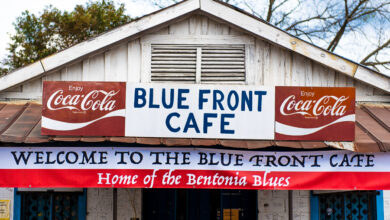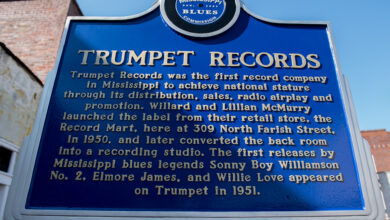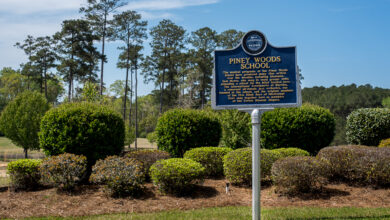Mississippi Blues Trails Series – Pensacola Blues
 An Article by Johnny Cole
An Article by Johnny Cole
Photos by Stephen Anderson
The history of Pensacola, Florida dates back to its original site in 1559, six years prior to the founding of St. Augustine. Throughout Pensacola’s history, its importance to the region has been vital culturally, economically and politically. For centuries, immigrants from all over the world have found their way to the great port city located on Florida’s northwest coast. I highly encourage readers to explore the region’s fascinating history.
Some of the earliest to settle the area were of African descent, many of them brought to the area as slaves. In this latest article of our Mississippi Blues Trail Series, we will be providing some details about the marker recognizing the Pensacola Blues. Obviously, not all the markers are located within the state of Mississippi, but these points of interest can clearly be traced back to the “Magnolia State”, the birthplace of America’s music. The Pensacola marker honors those descendants of slaves who helped to define the blues, jazz and R&B.
Pensacola’s African-American community has excelled, producing a proud legacy of influential leaders and neighborhoods such as Belmont-DeVilliers. Located on the western border of Downtown Pensacola, the black neighborhood around the intersection of Belmont and DeVilliers streets became known during the 20th century as “The Blocks”, a thriving hub of commercial activity catering to African-American residents. The culture of music, dance and celebration came to life in this district as it became a prominent stop on the famous “Chitlin Circuit” – the historically famous network of black-owned entertainment venues where legends were often made during the segregation era. Pensacola became a cornerstone of the Chitlin Circuit and a center of blues, ragtime, vaudeville and jazz activity.
 Top two photos: Recognizing the Pensacola Blues, The Mississippi Blues Trails marker #203 was dedicated on Jan. 18, 2019. It is located at the intersection of West Belmont Street and North De Villiers Street.
Top two photos: Recognizing the Pensacola Blues, The Mississippi Blues Trails marker #203 was dedicated on Jan. 18, 2019. It is located at the intersection of West Belmont Street and North De Villiers Street.
Abe’s 506 Club was one of the biggest and most well known venues located in “The Blocks”. Aretha Franklin, Ike & Tina Turner, B. B. King, Fats Domino, Ray Charles and others appeared at the once famous venue. Along with Abe’s 506 Club, there were the Savoy, Tom’s Tavern, Elks Lodge, Odd Fellows Hall, Club Rum Boogie, Harlem Club, Cotton Club, Saber Club, Bunny Club, Seville Quarter, The Fish House, and Five Sisters Blues Café. The Blocks was also home to WBOP radio and Gussie’s Record Shop.
Pensacola truly has enjoyed a wealth of entertainment and music activity. Local performers such as Wally “The Cat” Mercer, Ray Sheppard, Harold Andrews, Ida Goodson, Corrie Davis, Bo Bo Edwards and the Rounders often incorporated upbeat blues, jazz, pop and rhythm & blues into this music scene.Interestingly, Pensacola was among the first places to introduce blues singers on the theatrical stage. Ma Rainey “Mother of the Blues” and Mississippi-born Virginia Liston and others appeared the famous Belmont Theatre.
 The historic Belmont Theatre in Pensacola, FL. Before blues was even recognized as a musical genre, vocalists Ma Rainey from Georgia (later hailed as “The Mother of the Blues”), Mississippi-born Virginia Liston and others were performing at the Belmont Theatre, a marquee venue on the vaudeville circuit.
The historic Belmont Theatre in Pensacola, FL. Before blues was even recognized as a musical genre, vocalists Ma Rainey from Georgia (later hailed as “The Mother of the Blues”), Mississippi-born Virginia Liston and others were performing at the Belmont Theatre, a marquee venue on the vaudeville circuit.
The Mississippi influence was abundant throughout the era as legions of musicians and performers with Mississippi roots flocked to Pensacola to perform in its thriving music scene. Jimmy Reed, Sonny Boy Williamson, Junior Parker, Tyrone Davis, Syl Johnson, Bobby Rush, Denise LaSalle and James Carr frequently made stops in Pensacola.
A further example of the connection between Pensacola and Mississippi was the number Pensacola acts that performed and recorded in Mississippi. Wally Mercer, a singer and saxophonist, is one such example. In 1954, he recorded for the Jackson-based Trumpet label and made records in Nashville produced by the label’s owner Lillian McMurry, including “Rock Around the Clock” on Dot Records.
 Abe’s 506 Club was a popular chitlin circuit venue located in Pensacola, Florida. The venue closed its doors following a New Year’s Eve dance in 1981.
Abe’s 506 Club was a popular chitlin circuit venue located in Pensacola, Florida. The venue closed its doors following a New Year’s Eve dance in 1981.
By the end of the Sixties and Seventies as the segregation era came to a close, the once thriving neighborhood of “The Blocks” began to lose businesses, including its cherished music scene. One by one, clubs that were prominent fixtures on the Chitlin Circuit closed their doors. Following a New Year’s Eve dance in 1981, even Abe’s 506 Club bowed out. Sadly, the The Blocks neighborhood suffered as crime and “rundown” took hold of this historically important neighborhood. Thankfully, today things are seeing an upswing as smart and savvy business owners, investors and residents are reclaiming what was once great.
Pensacola was the birthplace or “one time” home to many blues, jazz and R&B acts. It was also a cornerstone of the Chitlin Circuit, hosting some of the greatest entertainment of the era with an obvious connection to the music of Mississippi, thus providing a wealth of reasons why the Mississippi Blues Trail marker was placed on the corner of Belmont and Devilliers Street at Five Sisters’ Blues Café, the former site of Gussie’s Record Shop and the historic African-American business and entertainment district.
The Southland Music Line invites you to visit the great city of Pensacola and investigate on its remarkable musical history.
Click Here for more articles in the Mississippi Blues Trail Series at The Southland Music Line with more coming soon.
Credits:
Mississippi Blues Trail and Mississippi Blues Commission
The Historical Marker Database
Page Designed & Edited by Johnny Cole
© The Southland Music Line. 2019. All rights reserved







